Full speed ahead
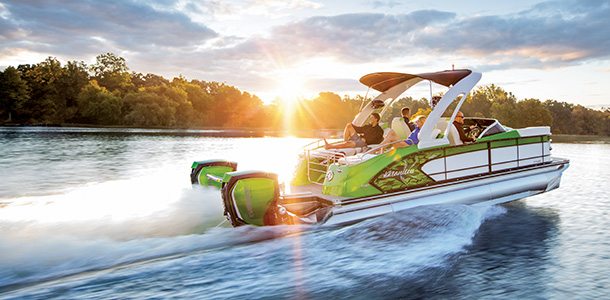
Continued strong sales growth fueled by innovative designs and unmatched versatility suggest a sunny future for the pontoon segment
While the recreational boating industry in North America has seen more than its share of highs and lows over the years, one constant has been the continued growth of the pontoon boat category. From humble beginnings where they were derided as little more than crude party rafts, pontoons have evolved steadily, adding luxurious refinements and performance enhancements, growing in popularity to the point where they now represent about one-third of all boat sales in North America. With their comfort, versatility and approachability, pontoons continue to gain market share while bringing steady, dependable profits to dealers and manufacturers alike.
From a national perspective, the pontoon category continues to enjoy steady, sustainable growth in the high single-digit range. According to the National Marine Manufacturers Association, American builders sold a total of 49,829 pontoon boats during the 2016 calendar year. This figure represents a solid 9.7 percent increase over the 45,440 boats sold during the 2015 calendar year, which was itself a gain of 9.3 percent over the 41,563 pontoon boats shipped to dealers during 2014.
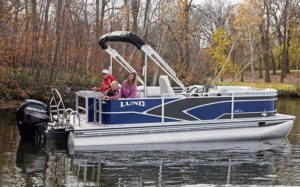
The reasons for continued growth in pontoons are many, with the primary driver being simple demographics. Aging boomers remain the single largest cohort of boat buyers, and the ability to simply step aboard onto a flat floor that’s roughly the same height as the dock has far more appeal than climbing over high gunnels or walking tightrope-style over a slippery deck.
Legitimate national appeal
The steady growth of the pontoon segment has been more or less consistent across North America. This is unique in an industry that is widely known for having distinct regional variances, the result of vastly different local boating conditions influencing consumer preference.
“Pontoon sales don’t seem to show any sort of regional pattern,” said Phil Smoker, vice president of sales for New Paris, Ind.-based Smoker Craft Inc., which manufactures a full line of pontoon boats under its Starcraft, Sylvan and SunChaser brands. “We have a fantastic dealer network that’s spread right across the U.S. and Canada, and demand for pontoons has been consistent across the map. In the Pacific Northwest boaters were a little slower to accept pontoons, but now they seem to be catching up. Canada was also a little bit slower to adopt pontoons at first, but today it’s become a very important pontoon market for us. Pontoon boats offer a lot of versatility, so that helps to give them a fairly universal appeal.”
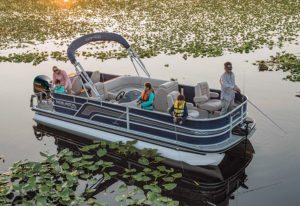
Statistical Surveys Inc. notes that pontoon boats exhibited positive growth in 12 of its top 15 North American Basic Trading Areas during the 2016 calendar year. What’s more, nine of those markets showed double-digit sales volume increases. Even the three BTAs that did not achieve year-over-year sales gains in 2016 (Milwaukee, Houston and Springfield, Mo.) came within an average of 5 percent of matching 2015 volumes. No other boat category can match this level of market consistency on a continental scale.
“Many boaters who weren’t specifically pontoon boat buyers continue to shift into our segment and that’s really what’s driving growth,” said Lori Melbostad, president of Wyoming, Minn.-based Premier Pontoons. “There’s no longer a stigma attached to pontoons. They’re luxurious, they have tremendous performance, and they’re becoming almost sexy. Yet they’re still far more affordable than a cruiser with the same passenger capacity and performance. The interesting thing is that we’re seeing people move into pontoons in different markets all over the country. There’s a clear, sustained movement toward pontoons boats and it’s consistent everywhere.”
With that universal consumer appeal, the key to growing sales — for some manufacturers at least — has been a matter of expanding their distribution footprint.
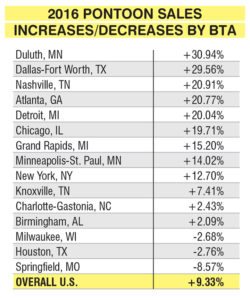
“Over the past year-and-a-half or two years we’ve seen huge growth,” said Greg VanWagenen, director of marketing and communications for Lansing, Mich.-based Manitou Pontoons. “Our sales two years ago were up almost 20 percent, and for last year they’re up around 22 percent over that. We’ve been aggressive in our efforts to grow our distribution network, and we’ve been signing new dealers in areas where we haven’t had much of a presence before, right across the States and into Canada. There is a strong demand for pontoon boats and we don’t see that changing any time soon.”
Size matters
While pontoon boats are produced in lengths from 16 to over 30 feet, the core of the market has traditionally been built around boats in the 21- to 23-foot range — large enough to accommodate the entire family, yet small enough to be easily towed and remaining approachable to a new boater. Pontoon boats in the 21-foot and 23-foot size range continue to reflect the strongest year-over-year sales growth according to SSI, posting increases of 32.69 percent and 22.03 percent, respectively.
“Most of our high-end product appeals to buyers coming into a pontoon from a cruiser, as well as existing pontoon owners who are looking to move up,” Melbostad said. “They’re attracted by the versatility and the additional space in a boat that’s affordable to buy and affordable to fuel. There’s some market pressure too, because they’re seeing pontoons everywhere on the water, their friends are buying pontoons, and they’re realizing there’s something going on here and they owe it to themselves to check it out.”

Larger pontoons appeal to other buyers with their ability to handle bigger water. Kelowna, British Columbia-based fiberglass runabout manufacturer Campion Marine stuck with its core competency when it entered the pontoon market in 2012, offering a pontoon product built entirely from fiberglass. Its Biltmore Fibertoon has gone on to enjoy unique success with boaters in coastal areas and on large lakes, where the product’s ability to absorb choppy water has given it a competitive advantage.
“The boat loves rough water, we have a lot of them on large freshwater lakes and a few in the Pacific Northwest,” said Campion Boats President Brock Elliott. “It’s reasonably comfortable in up to four-foot seas, so it appeals to people on bigger waters who used to own a cruiser.”
Regardless of their overall length, the pontoon segment continues to show a clear shift toward performance-oriented designs, increasingly with three tubes.
“For us, around 70 percent of what we build now are our three-tube boats,” said VanWagenen. “It’s the performance models that are really driving our growth. They let buyers enjoy water sports, they can go for a nice evening cruise, and for fun they can go fast and they offer amazing handling. We talk to a lot of buyers who have had a fiberglass boat their whole life, and they appreciate the additional seating and the versatility that a pontoon can offer. But they still want the performance capability. So a performance pontoon gives them the best of both worlds.”
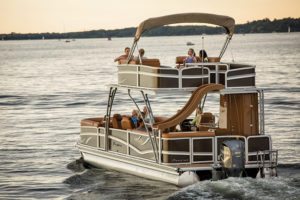
Although performance models continue to drive the bulk of pontoon boat sales, the category also enjoys robust sales of smaller boats – often to buyers on lakes that have horsepower restrictions. One of the pontoon boat’s great attributes is its ability to accommodate a large number of passengers in comfort, yet still deliver a pleasing ride even with a smaller engine. Pontoon tube designs have become so efficient that boaters can still have fun with comparatively little power, which makes them a natural choice for boaters on lakes with horsepower limits, or on lakes that are restricted to electric motors.
The rise of fishing models
Their ability to perform well with an electric motor has given pontoons an advantage in yet another market, as evidenced by their growing acceptance as fishing platforms. Their minimal draft allows pontoons to negotiate shallow waters with comparative ease, while their large amount of floor space allows multiple anglers to fish at once without fear of tangling lines. It’s an observation not lost on Smoker Craft, which offers more than 45 fishing-specific models between its various pontoon brands.
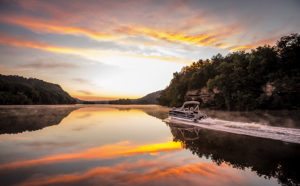
built around fishing as well.
“If you think about it, there isn’t a more stable casting platform out there,” said Smoker. “You have a lot of room to spread out, and you have all the amenities you could ask for with rod lockers, live wells, swivel seats and so on. A hard-core fisherman will still gravitate to a purpose-built fishing boat, but for more casual anglers, which is probably the majority of them, a pontoon brings a ton of additional benefits that make them more attractive to anglers who also need a versatile family boat.”
Evidence of the growing acceptance of pontoon boats by anglers was further reinforced during the 2016 season when New York Mills, Minn.-based aluminum fishing boat builder Lund Boats announced its plans to enter the pontoon market with the 2017 season. The company’s all-new LX series, targeting the mid-market, consists of five models offered on 21, 23 and 25 foot platforms, including both two-log and three-log boats suitable for both cruising and fishing, some complete with livewells, bait wells and rod lockers.
Lund’s announcement was followed a few weeks later by news that Flippin, Ark.-based bass boat manufacturer Ranger Boats was also entering the pontoon category with the introduction of its seven-model Reata series.
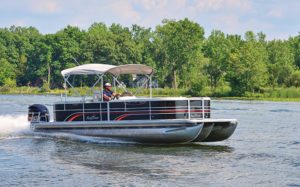
“In recent years fishing pontoons have evolved and provided higher-end comfort and quality. Our belief that Ranger is able to provide a product that combines the desire for a high-quality fishing boat with a pontoon platform,” said Mark Zwicker, senior sales and product manager at Ranger Boats. “The pontoon market is of course much more diverse than the fishing segment, and it is only natural that we would also diversify into the luxury cruise segment as well. To that end we have developed an all-inclusive line of Cruise models to complement the fish models. Based on the enthusiasm of our dealers, and orders already received, we are confident that our product goals are being achieved.”
With steadily growing sales of fishing, water sports and performance models every years, the once-humble party raft has clearly reached a level of widespread acceptance among consumers as a capable and versatile family boat. As manufacturers continue to develop new models with increasingly sophisticated features, performance and comfort, the outlook for the pontoon segment points to continued steady, sustainable growth.




